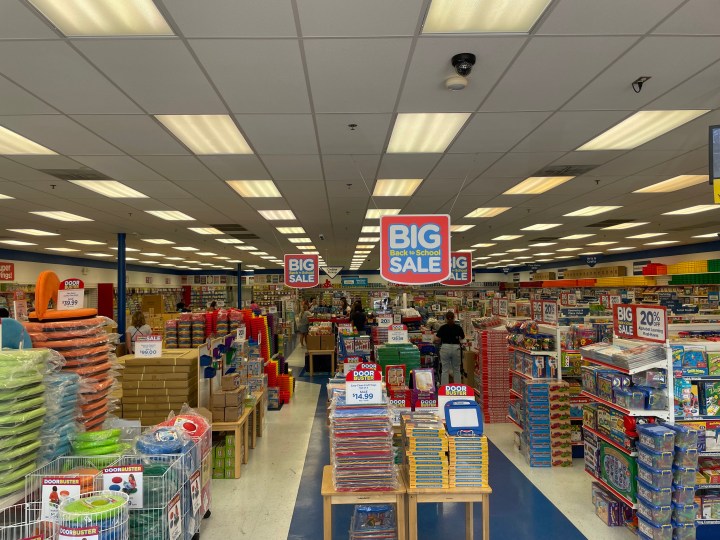
Inflation means teachers who buy their own supplies have to spend more or ask for help
Inflation means teachers who buy their own supplies have to spend more or ask for help

When New York City teacher Andy Yung gets his preschoolers ready for nap time, he transforms his public school classroom into a kind of blue green cave. The glow from the new colored lanterns helps his four-year-old students feel calm.
“One of them likes to just stare at it during nap time,” said Yung. “I think it helps her go to sleep.”
Yung bought the lanterns himself, then covered them with polyester batting to make them look like clouds. He also purchased LED lights, along with new picture books, folders, and a home for the class’s pet spider. It’s called a “cobweb castle.”

“I did have a spider that we caught outside in the playground,” said Yung. “It made its home in here, spun a few webs, laid a few egg sacks, and [then] it escaped.”
Yung spent $200 on the cobweb castle and the other materials, preparing for the upcoming school year. In the past, he’s spent more. (During the pandemic, when his preschool class went online, Yung paid for materials to create a puppet of himself to help with virtual teaching.) His district does have funding for supplies through an approved vendor website, but Yung said materials on that site can be limited.
“So if I wanted something like this cobweb castle, I would never be able to get it,” said Yung.
Yung also says it can take months for things to arrive through the approved website. For example, he ordered mats for the preschoolers to nap on in February that didn’t show up until June. So he just buys stuff himself. Sometimes he’s reimbursed, but sometimes not.

About 94% of public school teachers, in fact, used their own money to buy school supplies in the school year ending in 2015, according to the most recent federal data. The average amount teachers spent was $478. Nationally, elementary school teachers use more of their own money, on average, than middle or high school teachers. Educators in schools with more low-income kids spend more, too. This year, with inflation, teachers either have to spend more, spend less, or ask for help, from either their schools or their communities.
Districts could put more funding towards supplies, but often there’s pressure to put it towards teacher salaries, according to Marguerite Roza, director of the Edunomics Lab at Georgetown.
“When there is new money for the following year, there is a heavy push to put that into labor,” said Roza. “We’ll see collective bargaining say, ‘We should give that out for raises or hiring new staff’ and the supply bill gets squeezed.”
But with billions in federal relief funds at their disposal, and a deadline of September 2024 to spend it, districts could put more money toward supplies than they have in years past.
“They’re nervous about putting it all into labor costs that could be recurring, because the money stops,” said Roza. “So I think there will be more willingness for districts, on average, right now to cover costs.”
And those costs are up. Prices for things like notebooks, glue, and labels have increased 11% from a year ago.
At Lakeshore Learning, a teaching supply store north of Baltimore, business was brisk on a recent weekday. When shoppers enter the store, they’re hit with an onslaught of primary colors and 20% off signs. They can buy everything from tiny wooden chairs to a small toy cash register.
Outside the store, Bria Hamm, a public school teacher in Baltimore, showed off her purchases.
“I bought a number chart for my kids,” said Hamm. “Fat pencils, fat crayons, and little decals for decorations.”
Hamm says the district provides regular crayons and pencils, but the fat ones are easier for tiny hands to grip. She’s spent $35 so far, and is buying less than she might have in previous years.
“Prices are higher,” said Hamm. “This is the first year I actually did a wish list, as well, to try to get outside help with materials that I need, just basic materials like Kleenex tissues.”
Hamm’s wish list is online, and she says many of her friends and family members have bought things for her classroom. Other teachers use crowdfunding sites like DonorsChoose, a nonprofit platform specifically designed for educators. It’s seen requests nearly double from this time a year ago.
However it happens, Hamm says buying things for her classroom is a good investment for both her and her students.
“While we are there, it is our home,” said Hamm. “So if I have to spend money for it to be an inviting space, for them to feel safe, to feel comfortable, and to want to learn, then that’s just what I’m going to do, because it’s my space too.”
There’s a lot happening in the world. Through it all, Marketplace is here for you.
You rely on Marketplace to break down the world’s events and tell you how it affects you in a fact-based, approachable way. We rely on your financial support to keep making that possible.
Your donation today powers the independent journalism that you rely on. For just $5/month, you can help sustain Marketplace so we can keep reporting on the things that matter to you.

















